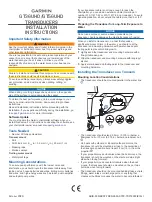
-
Wireless Systems
-
Ref.
11/551
MA153
4
3.
ACCENSIONE E TEST DELLA BATTERIA
Per mettere in funzione il trasmettitore, portare
linterruttore di accensione [
2
] in posizione
intermedia. Nel contempo, verificare che la spia
luminosa [
1
] si illumini; ciò sta a significare che
la batteria è inserita correttamente ed è carica;
in caso contrario verificare la corretta polarità
di inserzione della pila oppure sostituirla, in
quanto non più in grado di fornire la benché
minima energia.
4.
TONO PILOTA (*)
Il sistema radimicrofonico basa il suo
funzionamento sulla rilevazione ed identificazione
di un particolare segnale, detto tono pilota,
inviato dal trasmettitore con la frequenza
portante. Il circuito di ammutolimento, pertanto,
attiva il ricevitore solamente se il livello di segnale
ricevuto da entrambe le antenne è superiore al
livello di soglia impostato e solo se viene rilevato
il tono pilota. In questo modo, si evita che
all'impianto di diffusione giungano fruscii e rumori
di fondo generati da segnali indesiderati captati
in antenna.
5.
USO DEL TRASMETTITORE
Dopo aver acceso il trasmettitore, accertarsi che
il relativo ricevitore sia agganciato al segnale
trasmesso (in proposito fare riferimento alle
istruzioni del ricevitore).
Per abilitare il segnale audio della capsula,
portare linterruttore di accensione [
2
] verso
l'alto; regolare, a seconda delle necessità, il
livello sonoro tramite il controllo di volume di
ingresso del mixer o dellamplificatore a cui è
collegato il sistema radiomicrofonico.
Per silenziare la capsula microfonica portare
linterruttore [
2
] in posizione intermedia.
Terminato luso del sistema radiomicrofonico,
spegnere sempre il trasmettitore portando
linterruttore di accensione [
2
] verso il basso;
ciò consente di preservare la carica della batteria.
3.
SWITCHING ON AND BATTERY TEST
To start the transmitter, move the power switch
[
2
] to the intermediate position.
Make sure that the lamp [
1
] lights up,
indicating that the battery has been correctly
installed and is charged. If the lamp stays off,
check that the battery has been correctly
positioned, or replace it since it is dead.
4.
PILOT TONE (*)
The operation of this wireless microphone system
is based on the detection and identification of a
specific signal, the so-called pilot tone, sent by
the transmitter together with the carrier
frequency. The squelch circuit therefore only
activates the receiver if the level of the signal
received by both aerials is higher than the
threshold level that has been set, and only if the
pilot tone is detected. This prevents rustling and
other background noise generated by unwanted
signals picked up by the aerials from reaching
the broadcasting system.
5.
TRANSMITTER OPERATION
After switching on the wireless transmitter,
check that its receiver is hooked to the
transmitted signal (refer to the receiver users
instructions).
To enable the audio signal of the microphone
capsule, set the power switch [
2
] to the up
position; adjust the sound level as required
by means of the mixer or amplifier input
volume control to which the wireless system
is connected.
To mute the microphone capsule, set switch
[
2
] to intermediate position.
When the operation of the wireless system is
completed, always switch off the transmitter
by setting the power switch [
2
] to down
position in order to keep the battery charged.
(*)
mod. MA153-T1, MA153-T2, MA153-T3, MA153-T4.
(*)
mod. MA153-T1, MA153-T2, MA153-T3, MA153-T4.
11-551.p65
17/01/02, 14.52
4


































